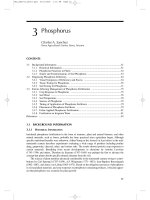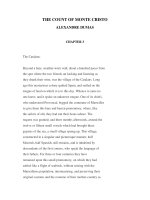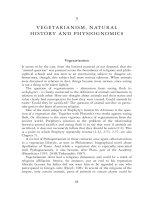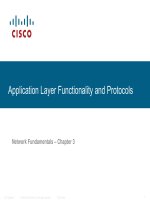Network Fundamentals–Chapter 3 pps
Bạn đang xem bản rút gọn của tài liệu. Xem và tải ngay bản đầy đủ của tài liệu tại đây (1.58 MB, 51 trang )
© 2006 Cisco Systems, Inc. All rights reserved. Cisco PublicITE I Chapter 6
1
Application Layer Functionality and Protocols
Network Fundamentals – Chapter 3
© 2006 Cisco Systems, Inc. All rights reserved. Cisco PublicITE 1 Chapter 6
2
Objectives
In this chapter, you will learn to:
– Describe how the functions of the three upper OSI model layers
provide network services to end user applications.
– Describe how the TCP/IP Application Layer protocols provide the
services specified by the upper layers of the OSI model.
– Define how people use the Application Layer to communicate
across the information network.
– Describe the function of well-known TCP/IP applications, such as
the World Wide Web and email, and their related services (HTTP,
DNS, SMB, DHCP, SMTP/POP, and Telnet).
– Describe file-sharing processes that use peer-to-peer applications
and the Gnutella protocol.
– Explain how protocols ensure services running on one kind of
device can send to and receive data from many different network
devices.
– Use network analysis tools to examine and explain how common
user applications work.
© 2006 Cisco Systems, Inc. All rights reserved. Cisco PublicITE 1 Chapter 6
3
OSI and TCP/IP Model
The Open Systems Interconnection
reference model is a layered, abstract
representation created as a guideline
for network protocol design.
–The OSI model divides the networking
process into 7 logical layers, each of which
has unique functionality and to which are
assigned specific services and protocols.
•In the OSI model, information is passed from
one layer to the next, starting at the
Application layer down the hierarchy to the
Physical layer,
•then passing over the communications
channel to the destination host, where the
information proceeds back up the hierarchy,
ending at the Application layer.
© 2006 Cisco Systems, Inc. All rights reserved. Cisco PublicITE 1 Chapter 6
4
OSI and TCP/IP Model: The Application Layer
The Application layer,
–Layer seven, is the top layer of both the OSI and
TCP/IP models.
–It is the layer that provides the interface
between the applications we use to communicate
and the underlying network over which our
messages are transmitted.
–Application layer protocols are used to
exchange data between programs running on the
source and destination hosts.
The TCP/IP protocol suite was developed prior
to the definition of the OSI model,
–The TCP/IP application layer protocols fit
roughly into the framework of the top three layers
of the OSI model: Application, Presentation
and Session layers.
•Most TCP/IP application layer protocols were
developed before the emergence of personal
computers, and graphical user interfaces. As a
result, these protocols implement very little of the
functionality that is specified in the OSI model
Presentation and Session layers.
© 2006 Cisco Systems, Inc. All rights reserved. Cisco PublicITE 1 Chapter 6
5
OSI and TCP/IP Model: The Presentation Layer
The Presentation Layer has three primary functions:
–Coding and conversion of Application layer data to
ensure that data from the source device can be
interpreted by the appropriate application on the
destination device.
–Compression of the data in a manner that can be
decompressed by the destination device.
–Encryption of the data for transmission and the
decryption of data upon receipt by the destination.
Examples include:
–QuickTime
•QuickTime is an Apple specification for video and audio,
–Motion Picture Experts Group (MPEG).
•MPEG is a standard for video compression and coding.
–Graphics Interchange Format (GIF), Joint
Photographic Experts Group (JPEG), and Tagged
Image File Format (TIFF).
•GIF and JPEG are compression and coding standards
for graphic images,
•TIFF is a standard coding format for graphic images.
© 2006 Cisco Systems, Inc. All rights reserved. Cisco PublicITE 1 Chapter 6
6
OSI and TCP/IP Model: The Session Layer
The Session Layer create and
maintain dialogs between source and
destination applications.
–The Session layer handles the exchange
of information to initiate dialogs, keep them
active, and to restart sessions that are
disrupted or idle for a long period of time.
Most applications, like web browsers
or e-mail clients, incorporate
functionality of the OSI layers 5, 6 and
7.
© 2006 Cisco Systems, Inc. All rights reserved. Cisco PublicITE 1 Chapter 6
7
OSI and TCP/IP Model
The widely-known Application layer protocols are
those that provide the exchange of information.
Among these TCP/IP protocols are:
–Domain Name Service Protocol (DNS) is used to
resolve Internet names to IP addresses.
–Hypertext Transfer Protocol (HTTP) is used to
transfer files that make up the Web pages of the
World Wide Web.
–Simple Mail Transfer Protocol (SMTP) is used for
the transfer of mail messages and attachments.
–Telnet, a terminal emulation protocol, is used to
provide remote access to servers and networking
devices.
–File Transfer Protocol (FTP) is used for interactive
file transfer between systems.
The protocols in the TCP/IP suite are generally
defined by Requests for Comments (RFCs).
–The Internet Engineering Task Force maintains the
RFCs as the standards for the TCP/IP suite.
© 2006 Cisco Systems, Inc. All rights reserved. Cisco PublicITE 1 Chapter 6
8
Application Layer Software
The functions associated with the Application
layer protocols enable our human network to
interface with the underlying data network.
There are two forms of software programs or
processes that provide access to the network:
applications and services.
–Network-Aware Applications
•Applications are the software programs used by
people to communicate over the network.
•E-mail clients and web browsers are examples of
these types of applications.
–Application layer Services
•Other programs may need the assistance of
Application layer services to use network resources,
like file transfer or network print spooling.
•Though transparent to the user, these services are
the programs that interface with the network and
prepare the data for transfer.
© 2006 Cisco Systems, Inc. All rights reserved. Cisco PublicITE 1 Chapter 6
9
User Applications, Services and Application Layer Protocols
In the OSI model, applications that interact directly
with people are considered to be at the top of the
stack, as are the people themselves.
As mentioned previously, the Application layer uses
protocols that are implemented within applications
and services.
–While applications provide people with a way to create
messages and
–application layer services establish an interface to the
network,
–protocols provide the rules and formats that govern
how data is treated.
All three components may be used by a single
executable program and may even use the same
name.
–For example, when discussing "Telnet" we could be
referring to the application, the service, or the protocol.
© 2006 Cisco Systems, Inc. All rights reserved. Cisco PublicITE 1 Chapter 6
10
Application Layer Protocol Functions
Application layer protocols are used by both the source
and destination devices during a communication
session.
–In order for the communications to be successful, the
application layer protocols implemented on the source
and destination host must match.
Application layer protocols functions:
–Protocols establish consistent rules for exchanging data
between applications and services loaded on the
participating devices.
–Protocols specify how data inside the messages is
structured and the types of messages that are sent
between source and destination.
•These messages can be requests for services,
acknowledgments, data, status, or error messages.
–Protocols also define message dialogues, ensuring that
a message being sent is met by the expected response
when data transfer occurs.
–Applications and services may also use multiple
protocols in the course of a single conversation.
•One protocol may specify how to establish the network
connection and another describe the process for the data
transfer when the message is passed to the next lower layer.
© 2006 Cisco Systems, Inc. All rights reserved. Cisco PublicITE 1 Chapter 6
11
The Client-Server Model
Client and server processes are considered to be in the
Application layer.
–the device requesting the information is called a client
–the device responding to the request is called a server.
–Application layer protocols describe the format of the
requests and responses between clients and servers.
One example of a client/server network is a corporate
environment where employees use a company e-mail
server to send, receive and store e-mail.
–The e-mail client on an employee computer issues a
request to the e-mail server for any unread mail.
–The server responds by sending the requested e-mail to
the client.
Data is typically flowing from the server to the client,
some data always flows from the client to the server.
–For example, a client may transfer a file to the server for
storage purposes (upload).
–Data from a server to a client as a download.
© 2006 Cisco Systems, Inc. All rights reserved. Cisco PublicITE 1 Chapter 6
12
Servers
In a general networking context, any device that
responds to requests from client applications is
functioning as a server.
–A server is usually a computer that contains information
to be shared with many client systems.
–For example, web pages, documents, databases,
pictures, video, and audio files can all be stored on a
server and delivered to requesting clients.
–In other cases, such as a network printer, the print
server delivers the client print requests to the specified
printer.
–Some servers may require authentication of user
account information to verify if the user has permission to
access the requested data or to use a particular
operation.
•if you request to upload data to the FTP server, you may
have permission to write to your individual folder but not to
read other files on the site.
© 2006 Cisco Systems, Inc. All rights reserved. Cisco PublicITE 1 Chapter 6
13
Servers
In a client/server network, the server runs a
service, or process, sometimes called a server
daemon.
–Like most services, daemons typically run in the
background and are not under an end user's direct
control.
–Daemons are described as "listening" for a
request from a client, because they are
programmed to respond whenever the server
receives a request for the service provided by the
daemon.
–When a daemon "hears" a request from a client, it
exchanges appropriate messages with the client,
as required by its protocol, and proceeds to send
the requested data to the client in the proper
format.
© 2006 Cisco Systems, Inc. All rights reserved. Cisco PublicITE 1 Chapter 6
14
Application Layer Services and Protocols
A single application may employ many different
supporting Application layer services;
–thus what appears to the user as one request for
a web page may, in fact, amount to dozens of
individual requests.
–And for each request, multiple processes may be
executed.
–For example, a client may require several
individual processes to formulate just one request
to a server.
Additionally, servers typically have multiple
clients requesting information at the same time.
–For example, a Telnet server may have many
clients requesting connections to it simultaneously
–The Application layer processes and services rely
on support from lower layer functions to
successfully manage the multiple conversations.
© 2006 Cisco Systems, Inc. All rights reserved. Cisco PublicITE 1 Chapter 6
15
Application Layer Services and Protocols
A single application may employ many different
supporting Application layer services;
–Demo:
© 2006 Cisco Systems, Inc. All rights reserved. Cisco PublicITE 1 Chapter 6
16
The Peer-to-Peer Model
In addition to the client/server model for networking, there is
also a peer-to-peer model.
–Peer-to-peer networking involves two distinct forms: peer-to-peer
network design and peer-to-peer applications (P2P).
Peer-to-Peer Networks
–In a peer-to-peer network, two or more computers are connected
via a network and can share resources (such as printers and files)
without having a dedicated server.
–Every connected end device (known as a peer) can function as
either a server or a client.
•One computer might assume the role of server for one transaction while
simultaneously serving as a client for another.
A simple home network with two computers sharing a printer is
an example of a peer-to-peer network.
–Each person can set his or her computer to share files, enable
networked games, or share an Internet connection.
Because peer-to-peer networks usually do not use centralized
user accounts, permissions, or monitors
–it is difficult to enforce security
© 2006 Cisco Systems, Inc. All rights reserved. Cisco PublicITE 1 Chapter 6
17
Peer-to-Peer Applications
Peer-to-Peer (P2P) Applications
–A P2P application, allows a device to act as both a client
and a server within the same communication.
–However, peer-to-peer applications require that each end
device provide a user interface and run a background
service.
•When you launch a specific P2P application it invokes the
required user interface and background services.
Some P2P applications use a hybrid system where
resource sharing is decentralized but the indexes that
point to resource locations are stored in a centralized
directory.
–In a hybrid system, each peer accesses an index server
to get the location of a resource stored on another peer.
–The index server can also help connect two peers, but
once connected, the communication takes place between
the two peers without additional communication to the
index server.
Peer-to-peer applications can be used on peer-to-peer
networks, client/server networks, and across the
Internet.
© 2006 Cisco Systems, Inc. All rights reserved. Cisco PublicITE 1 Chapter 6
18
Services and Protocol: Port Number
As we will see later in this course, the Transport layer
uses an addressing scheme called a port number.
–Port numbers identify applications and Application layer
services that are the source and destination of data.
–Server programs generally use predefined port numbers
that are commonly known by clients.
–As we examine the different TCP/IP Application layer
protocols and services, we will be referring to the TCP
and UDP port numbers associated with these services.
Some of these services are:
–Domain Name System (DNS) - TCP/UDP Port 53
–Hypertext Transfer Protocol (HTTP) - TCP Port 80
–Simple Mail Transfer Protocol (SMTP) - TCP Port 25
–Post Office Protocol (POP) - UDP Port 110
–Telnet - TCP Port 23
–Dynamic Host Configuration Protocol - UDP Port 67
–File Transfer Protocol (FTP) - TCP Ports 20 and 21
© 2006 Cisco Systems, Inc. All rights reserved. Cisco PublicITE 1 Chapter 6
19
Services and Protocol: Port Number
Domain Name System (DNS) - TCP/UDP Port 53
–TCP is used for "zone transfers" of full name record databases, while UDP is used for
individual lookups.
Hypertext Transfer Protocol (HTTP) - TCP Port 80
Simple Mail Transfer Protocol (SMTP) - TCP Port 25
–SMTP is a long established Internet protocol that is used for the delivery and receipt of
e-mail.
Post Office Protocol (POP) - UDP Port 110
–POP3 is only to collect e-mail
–To collect e-mail you have a choice of POP3 or SMTP. However, you can only use
SMTP with software that is SMTP aware such as Microsoft Exchange. Outlook and
Outlook Express cannot on their own receive e-mail using SMTP.
–When configuring your e-mail software (e.g. Outlook or Outlook Express) you always
need to specify the name or IP address of the SMTP server for outgoing e-mail.
Telnet - TCP Port 23
Dynamic Host Configuration Protocol - UDP Port 67
File Transfer Protocol (FTP) - TCP Ports 20 and 21
© 2006 Cisco Systems, Inc. All rights reserved. Cisco PublicITE 1 Chapter 6
20
Services and Protocol: Port Number
Dynamic Host Configuration Protocol - UDP Port 67 and 68
When a system starts up on a network it must first request an IP address (assume it is not using a static
IP address), and it does this by broadcasting a request to the DHCP server:
UDP 0.0.0.0:68 -> 255.255.255.255:67
–since the requesting system doesn't have an IP address (why it is asking) it uses 0.0.0.0 and since its new to the
network it doesn't know where the DHCP server is, so it broadcasts the request to the entire network
(255.255.255.255).
The DHCP server then responds with something like:
UDP 192.168.1.1:67 -> 255.255.255.255:68
–This is typically a DHCP offer. NOTE it has to be broadcasted (255.255.255.255) as the requesting system doesn't
yet have an IP address (its contained in the offer). The data in this transmission contains the IP and other network
configuration information that the requesting system needs to connect to the network (lease time, Subnet Mask, etc).
Sometimes you will see something like:
UDP 192.168.1.101:67 -> 192.168.1.1:68
–as a request, followed by a reply
UDP 192.168.1.1:68 -> 192.168.1.101:67
–These are typically IP renewal requests, where a system has an IP address and is asking to renew it (ie get the
lease extended). Since the requesting system knows where the DHCP server is and it already has a current IP
address the requests don't need to use 0.0.0.0 and 255.255.255.255.
/>© 2006 Cisco Systems, Inc. All rights reserved. Cisco PublicITE 1 Chapter 6
21
DNS
In data networks, devices are labeled with numeric IP
addresses, so that they can participate in sending and
receiving messages over the network.
–However, most people have a hard time remembering
this numeric address.
–Hence, domain names were created to convert the
numeric address into a simple, recognizable name.
On the Internet these domain names, such as
www.cisco.com, are much easier for people to
remember than 198.133.219.25, which is the actual
numeric address for this server.
–Also, if Cisco decides to change the numeric address, it
is transparent to the user, since the domain name will
remain www.cisco.com.
–The new address will simply be linked to the existing
domain name and connectivity is maintained.
The DNS was created for domain name to address
resolution for these networks.
–DNS uses a distributed set of servers to resolve the
names associated with these numbered addresses.
© 2006 Cisco Systems, Inc. All rights reserved. Cisco PublicITE 1 Chapter 6
22
DNS Services and Protocol
DNS is a client/server service;
–It differs from the other client/server services that we are
examining.
–While other services use a client that is an application
(such as web browser), the DNS client runs as a service
itself.
•The DNS client, sometimes called the DNS resolver, supports
name resolution for our other network applications and other
services that need it.
Computer operating systems also have a utility called
nslookup that allows the user to manually query the
name servers to resolve a given host name.
–This utility can also be used to troubleshoot name
resolution issues and to verify the current status of the name
servers.
–In the first query in the figure, a query is made for
www.cisco.com. The responding name server provides the
address of 198.133.219.25.
© 2006 Cisco Systems, Inc. All rights reserved. Cisco PublicITE 1 Chapter 6
23
DNS Services and Protocol
Server 198.6.1.3
Demo: Internal DNS and external DNS server
© 2006 Cisco Systems, Inc. All rights reserved. Cisco PublicITE 1 Chapter 6
24
DNS Services and Protocol
A DNS server provides the name resolution using
the name daemon, which is often called named,
(pronounced name-dee).
The DNS server stores different types of resource
records used to resolve names. These records
contain the name, address, and type of record.
Some of these record types are:
–A - an end device address
–NS - an authoritative name server
–CNAME - the canonical name (or Fully Qualified
Domain Name) for an alias; used when multiple
services have the single network address but each
service has its own entry in DNS
–MX - mail exchange record; maps a domain name to a
list of mail exchange servers for that domain
© 2006 Cisco Systems, Inc. All rights reserved. Cisco PublicITE 1 Chapter 6
25
DNS Services and Protocol
A - an end device address
–You can use a A record whenever you have to assign a specific IP to a domain name or to a
subdomain.
–Suppose you have the somedomain.tld domain and want to assign 10.10.0.1 IP address to your web
server, then you should create an A record with "www.somedomain.tld" as Fully Qualified Domain
Name and "10.10.0.1" in the value field.
NS - an authoritative name server
–An authoritative name server is a name server that can give an authoritative answer to a DNS
query, and not just a cached answer that was given by another name server. All primary and
secondary name servers give authoritative answers, as can certain other "shadow" name servers.
CNAME - the canonical name (or Fully Qualified Domain Name) for an alias; used when
multiple services have the single network address but each service has its own entry in DNS
–You should use a CNAME record whenever you want associate a new subdomain to an already
existing A record; i.e. you can make "www.somedomain.tld" to "somedomain.tld", which should
already have been assigned an IP with an A record.
MX - mail exchange record; maps a domain name to a list of mail exchange servers for that
domain
–When an e-mail message is sent through the Internet, the sending mail transfer agent makes a DNS
query requesting the MX records for each recipient's domain name, which is the portion of the e-mail
address following the "@". This query returns a list of host names of mail exchange servers accepting
incoming mail for that domain, together with a preference number.
/> />









